Under Canada’s new modern slavery legislation, the Fighting Against Forced Labour and Child Labour in Supply Chains Act, applicable entities must file a report by May 31 each year describing the risks of forced labour and child labour in their business and supply chains and steps taken to address those risks.
The federal government received 5,650 reports by the first deadline of May 31, 2024. We reviewed a sample of the filed reports to assess trends in the governance measures, supply chain due diligence, procurement practices and other steps taken by companies during the first reporting year to reduce the risks of modern slavery. We reviewed 1,275 reports, which is approximately 23% of the reports filed by companies and other entities by the deadline. This article summarizes the key findings from our review.
Governance Measures
The Act requires reporting entities to disclose their policies and due diligence processes in relation to forced labour and child labour. The OECD Due Diligence Guidance for Responsible Business Conduct recommends as a key first step that companies embed responsible business conduct into their policies and management systems.
While a corporation’s board of directors is ultimately responsible for governance and risk oversight, it is not uncommon, particularly in public companies, for boards to delegate certain responsibilities to one or more committees of directors. Although reporting entities did not commonly disclose in their reports the extent to which oversight of modern slavery-related risks and governance was delegated to a committee of the board or other governing body, for those that did, the most commonly cited committees were the sustainability committee (26%), corporate governance committee (24%) and audit committee (19%).
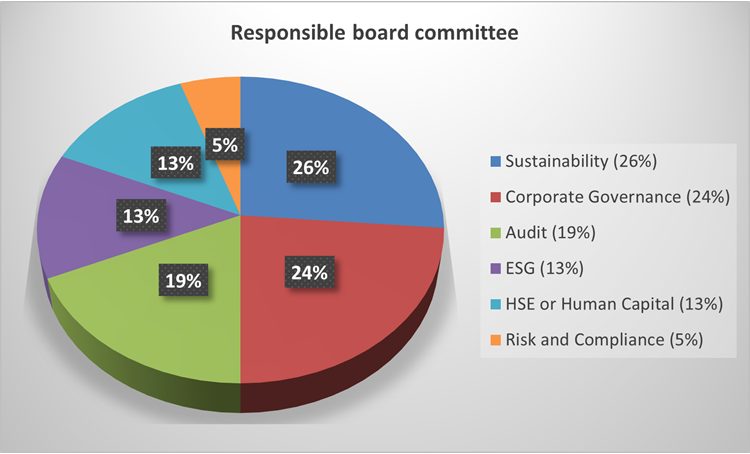
The vast majority of reports we reviewed contained information about internal human rights-related policies, with 74% of reports referencing an internal code of conduct or ethics. Other commonly held corporate policies included human rights policies (29%) and whistleblower policies (36%).
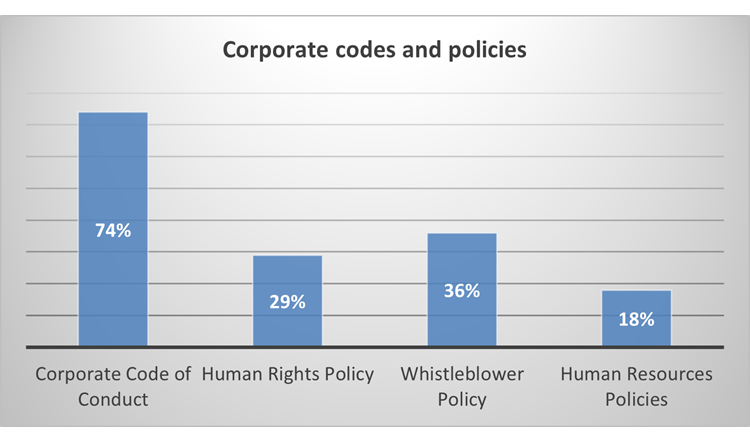
Supplier Policies, Due Diligence and Procurement Practices
Given the requirement in the Act to identify the steps taken to prevent and reduce the risk that forced labour or child labour is used at any step of the production of goods in Canada or elsewhere by the entity or of goods imported into Canada by the entity, a large focus of many of the reports we reviewed was on supplier-related policies, due diligence measures and procurement practices.
We found that almost half of companies surveyed had a supplier code of conduct in place, and 7% required their suppliers to annually certify their compliance with the code. Smaller numbers of companies reported having in place a procurement policy (15%) or a responsible sourcing policy (13%). Approximately 17% of companies reported including anti-modern slavery-related terms and conditions in their supply contracts. These types of contractual terms typically require suppliers to comply with certain obligations, including imposing conditions and requirements on their own suppliers, thereby helping companies exert control further down their supply chains.
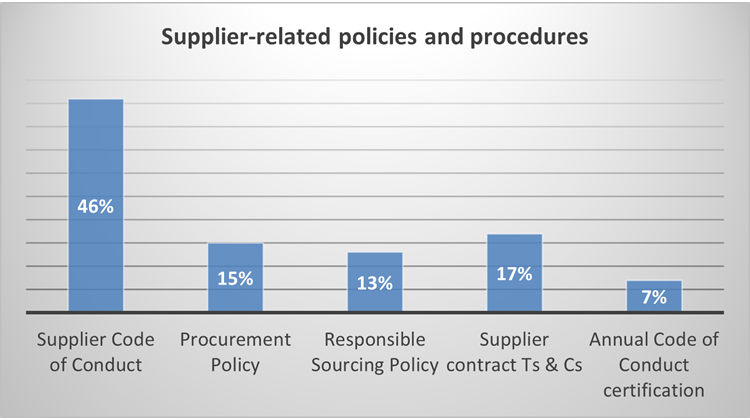
In this first year of reporting under the Act, companies are at varying stages in terms of the progress made to map and understand the risks present in their supply chains. While 61% reported having undertaken some form of due diligence and risk assessment efforts internally, only 13% indicated they had engaged a third party to assist with due diligence efforts. Among the approaches taken to assess risk, 15% indicated they send questionnaires to their suppliers, while 7% screen their suppliers according to public watchlists (including sanctions lists) and 3% screen for adverse media coverage.

Training
The Act requires reporting entities to include information on the training provided to employees on forced labour and child labour, if any. Guidance published by the federal government to assist entities understand their reporting requirements advises that training may take a range of forms, from formal training courses to awareness-raising activities.
During this first reporting period, slightly more than half of the companies we surveyed reported they had provided training to employees in the form of annual code of conduct and policy reviews. A smaller number (20%) reported having provided more dedicated training on the issues of forced labour and child labour.
Remediation
Another requirement of the Act is to provide information on the measures taken, if any, to remediate any forced labour or child labour. The vast majority of the reports we reviewed were either silent on this point or indicated affirmatively that no instances of forced labour or child labour had been found and therefore no remediation measures had been required. A small number of entities (5%) indicated they had taken remediation measures in the previous financial year.
Measurement of Effectiveness
The Act asks reporting entities to explain how they assess their effectiveness in ensuring forced labour and child labour are not being used in their business and supply chains. The federal government’s guidance advises that entities may indicate they have not yet taken any actions in this regard.
Approximately 41% of entities we surveyed indicated they had taken general measures to begin to assess the effectiveness of their actions. However, only 6% reported having specific performance indicators in place. Given that this was only the first year of reporting and many companies are only beginning to put in place policies, due diligence procedures and other measures, it is not surprising that few entities have introduced performance indicators.
Compliance Issues
Not all companies that filed reports appear to have complied with the requirements set out in the Act. Some of the variations include the following:
Report structure
- Use of questionnaire as report. Several companies (15 in our sample) filed a copy of the online questionnaire that was required to be completed when filing the report, rather than a separate report. The federal government’s guidance originally suggested that the questionnaire could be used as a template for preparing the report, stating that entities could use the exact same information and structure in the questionnaire as in the report. However, when the guidance was amended in March 2024, the government clarified that the questionnaire could be used as a resource to help develop the report, but any suggestion that it is acceptable as a template or method of structuring the report was removed.
- Use of supplier letters as report. One company, instead of preparing a report containing the information required by the Act, filed a 73-page compilation of template letters from suppliers confirming their compliance with the Act.
- Use of global reports. A number of companies filed reports that were prepared for countries with similar legislation, such as Australia and the UK, but did not reference the Canadian Act or appear to meet the specific legislative requirements of the Act, such as including the required attestation and board signature. The federal government’s guidance specifies that companies may use the information submitted in a report produced for other jurisdictions, but only so long as the report meets all of the criteria and requirements of the Canadian Act.
Posting of report on company website
The Act requires reporting entities to post a copy of their reports “in a prominent place” on their websites. The federal government’s guidance states that it must be “visible and readily accessible.” Notwithstanding this requirement, the report could not readily be found on the websites of more than half of the companies we surveyed.
One reason for the difficulty in finding reports may be that the Act does not prescribe where or how the report should be filed on a corporate website. The federal government’s guidance provides that companies may use their discretion in determining the appropriate place. As a result, companies took a variety of approaches, with the most common locations being: (1) the bottom of the website next to the website terms of use, privacy policy and other legal notices (52%), (2) the “about us” section of the website (18%), (3) the sustainability / corporate responsibility / ESG section (13%) and (4) the area of the website dedicated to investor relations (7%). As would be expected, the location of the report depended on the size of the company and existing structure of its website, with publicly listed companies more likely to post their reports on the investor relations section of their websites.
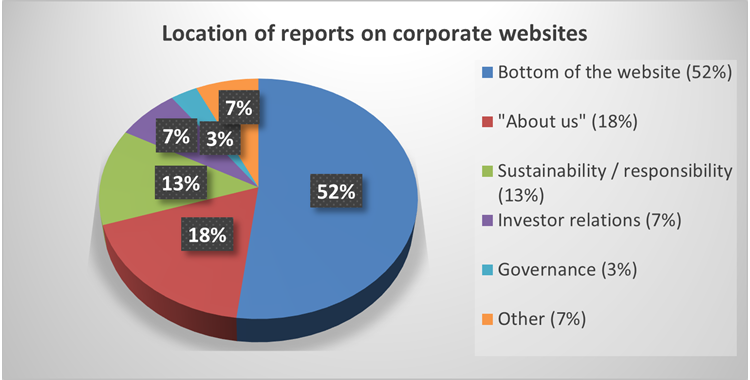
Another reason for the difficulty in locating reports on company websites results from the wide variety of names given to the reports. Common names included “modern slavery disclosure,” “forced and child labour report,” “human rights statement” and “transparency in supply chain disclosure.” Other less descriptive names for the report included “corporate commitment,” “social compliance” and even “other.”
Another reason we were unable to locate the reports of fewer than half of the companies surveyed is that a number may not have been aware of the requirement and therefore did not post the report on their websites at all. Anyone looking to find the report of a particular company can search the library catalogue on the Public Safety Canada website, which contains the reports filed with the federal government.
Report Format
Although the Act itself does not set any requirements or restrictions on the format of the report, the federal government’s guidance recommends that reports not exceed 10 pages in length. In our survey sample, we found that reports ranged in length from half a page to 57 pages, with the most common length being four pages (being the length of 20% of reports).
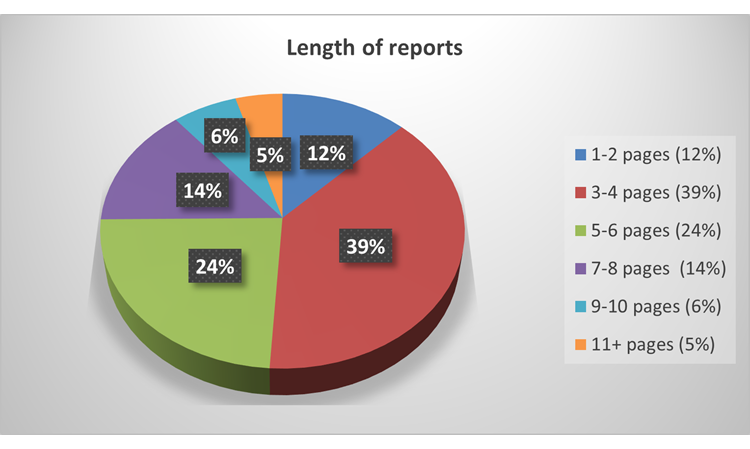
Generally speaking, the longer reports tended to be global in nature. In other words, they were prepared by multinational corporations with reporting obligations outside of Canada in addition to under the Canadian Act. Global reports were also more likely to include photos, graphics and other design elements. Approximately 20% of the reports we reviewed were published in a more elevated design format similar to how many sustainability reports are often presented.
Annual Report to Parliament
In addition to our review of reports filed this past year, the federal government has also released the findings of its own review. The Act requires the Minister of Public Safety to provide to Parliament, on or before September 30 of each year, a report summarizing the key findings from the previous reporting period, including the activities that entities have reported carry a risk of forced labour or child labour being used and the steps they have taken to assess and manage that risk and to remediate any issues found.
Public Safety Canada is also required to include information about any orders to enforce compliance with the Act and any charges laid under it. The report confirms that no orders were made or charges laid against any person. This is consistent with Public Safety Canada’s comments in early 2024 that the government would take a more educational approach in this first year of reporting.
A copy of the report is available from the Library of Parliament and we understand it will be made accessible on the Public Safety Canada website in the coming weeks. Our summary of the government’s report is available here.
Conclusion and Next Steps
Our review of almost a quarter of the reports filed by entities this past year reveals a wide range in terms of the depth of the reports, the steps taken to identify the risks of forced labour and child labour being used and the steps taken to mitigate those risks. As this was the first year of reporting, we anticipate this will form a baseline from which the actions and efforts taken by entities will grow over time. This would be consistent with our experience in other jurisdictions that have had reporting legislation in place for a number of years already, such as the UK and Australia.
The next annual reports are due by May 31, 2025.
Stay up to date with further developments by visiting our modern slavery legislation hub.











